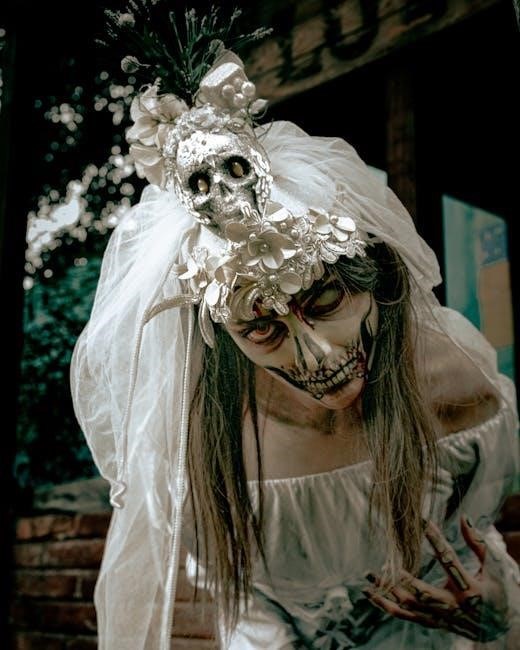John Donne’s “Death Be Not Proud” is a Holy Sonnet that personifies Death, challenging its perceived power. It argues Death is not mighty or dreadful, as it cannot truly kill, but merely transitions souls to eternal life. The poem, written in Donne’s metaphysical style, explores themes of mortality, the afterlife, and divine judgment, showcasing his mastery of religious and philosophical discourse.
First published posthumously in 1633, the poem has become one of Donne’s most celebrated works, admired for its intellectual depth and emotional resonance. Its exploration of Death’s illusion of might continues to resonate with readers, making it a timeless reflection on human existence and the divine.
Overview of the Poem
John Donne’s “Death Be Not Proud” is a thought-provoking Holy Sonnet that challenges Death’s authority. The poem personifies Death, addressing it directly to argue that it is not as powerful as it seems. Donne contends that Death is merely a temporary state, comparable to sleep, and serves a higher purpose. He asserts that Death cannot truly kill, as it transitions souls to eternal life. The poem’s central argument is that Death’s might is an illusion, and its power is limited by forces beyond its control. This themes of mortality, the afterlife, and divine judgment are explored with Donne’s characteristic wit and metaphysical depth.
Historical Context of the Poem
John Donne wrote “Death Be Not Proud” in 1617, a period marked by personal loss and spiritual reflection. The poem was part of his Holy Sonnets, composed after the death of his wife and during his own illness. Published posthumously in 1633, it reflects the religious and philosophical debates of 17th-century England. The poem’s themes resonate with the cultural and theological shifts of the time, blending Christian theology with Donne’s metaphysical style. Its exploration of mortality and the afterlife aligns with the era’s preoccupation with death and divine judgment, making it a significant work of early modern literature.
John Donne’s Style and Themes
John Donne’s style in “Death Be Not Proud” exemplifies his metaphysical approach, blending complex theological ideas with vivid imagery and logical argumentation. His use of personification, metaphor, and paradox creates a dynamic dialogue with Death, challenging its authority. Themes of mortality, divine judgment, and the afterlife are central, reflecting Donne’s preoccupation with spiritual introspection. His wit and intellectual rigor, combined with emotional depth, characterize his unique poetic voice. Donne’s exploration of Death’s powerlessness underscores his belief in eternal life, offering a profound meditation on human existence and the divine, making the poem a masterpiece of 17th-century English literature.

Literary Devices in “Death Be Not Proud”
Donne employs personification, metaphor, and paradox to challenge Death’s might. His rhetorical address to Death, using irony and logical argumentation, underscores the illusion of Death’s power, revealing its true nature as a mere transition to eternal life, stripping it of its feared authority, and emphasizing its subjugation to divine will.
Personification of Death
In “Death Be Not Proud,” Donne masterfully personifies Death, addressing it directly as a prideful entity. By attributing human qualities to Death, Donne diminishes its intimidation, portraying it as a mere servant to higher forces. Death is not a fearsome ruler but a subordinate to nature and God, stripping it of its terrifying aura. Donne’s personification challenges the common perception of Death as mighty, instead revealing it as a powerless figure that cannot truly kill, only transition souls to eternal life. This bold personification underscores the poem’s central argument: Death’s might is an illusion, and its pride is unwarranted.
Use of Metaphor and Simile
Donne employs vivid metaphors and similes to diminish Death’s grandeur. He compares Death to a “slave” bound by forces beyond its control, stripping it of its terrifying aura. Sleep and rest are likened to “pictures” of Death, suggesting they are mere imitations of its power. Donne’s metaphors, such as “Death is not mighty,” reshape the reader’s perception, presenting Death as a natural transition rather than an end. These literary devices create a powerful contrast, emphasizing the illusion of Death’s might and reinforcing the poem’s central theme of its powerlessness. Donne’s imagery challenges the fear of Death, rendering it less formidable and more relatable. His metaphors and similes are central to the poem’s persuasive force, making Death seem ordinary and stripped of its dread. Through these comparisons, Donne underscores the transient nature of Death’s authority, aligning it with a broader philosophical and religious perspective. By using such evocative language, Donne transforms Death from a fearsome entity into a mere stepping stone to eternal life. His metaphors and similes are not only stylistic choices but also integral to the poem’s argument, making “Death Be Not Proud” a masterclass in rhetorical strategy. Donne’s use of metaphor and simile ensures that Death is seen as a servant to nature and God, rather than a ruler, thereby comforting the reader with the promise of an afterlife beyond Death’s reach. This approach underscores the poem’s religious undertones, where Death is not an end but a beginning. Donne’s metaphors and similes are thus both elegant and profound, offering a deeper understanding of mortality and the divine. By personifying Death and using such comparisons, Donne creates a compelling narrative that challenges the reader to reconsider their fear of Death. His use of metaphor and simile is a testament to his skill as a poet and thinker, blending beauty with intellectual depth. The poem’s imagery, shaped by these devices, remains timeless, resonating with readers across centuries. Donne’s mastery of metaphor and simile ensures that “Death Be Not Proud” continues to inspire reflection on mortality and the afterlife. Through these literary tools, Donne achieves a balance between artistry and philosophy, making the poem both accessible and profound. His metaphors and similes are not only decorative but also essential to the poem’s message, proving that Death’s might is but an illusion. Donne’s work stands as a testament to the power of language in shaping our understanding of life’s greatest mysteries. By engaging with the poem’s metaphors and similes, readers gain a deeper appreciation for Donne’s intellectual and artistic genius. His use of these devices in “Death Be Not Proud” ensures that the poem remains a cornerstone of literary and philosophical discourse. Donne’s metaphors and similes are a celebration of life’s continuity beyond Death, offering hope and comfort to all who confront the inevitability of mortality. Through such imagery, Donne transcends the boundaries of time, making his poem a universal meditation on existence. His metaphors and similes are a bridge between the earthly and the divine, guiding readers toward a greater understanding of life’s purpose. Donne’s work, enriched by these devices, continues to inspire and enlighten, proving the enduring power of poetry to explore life’s profound questions. His use of metaphor and simile in “Death Be Not Proud” is a masterful blend of art and philosophy, ensuring the poem’s relevance across generations. Donne’s imagery not only challenges the fear of Death but also offers a vision of life beyond it, grounded in faith and intellectual curiosity. Through such metaphors and similes, Donne achieves a poetic triumph, making “Death Be Not Proud” a work of lasting significance. His use of these devices is a testament to his ability to transform complex ideas into beautiful and accessible poetry, ensuring that his work remains a vital part of literary tradition. Donne’s metaphors and similes are a celebration of life’s resilience and the promise of eternity, offering readers a profound and enduring message. By engaging with the poem’s imagery, readers not only appreciate its artistic merit but also gain insight into the human condition. Donne’s use of metaphor and simile in “Death Be Not Proud” is a testament to his genius as a poet and thinker, ensuring that his work continues to inspire and provoke thought. His imagery is a bridge between the past and the present, making the poem a timeless exploration of mortality and the divine. Donne’s metaphors and similes are a gift to literature, offering readers a deeper understanding of life and death. Through such devices, Donne’s poetry remains a source of comfort, hope, and intellectual stimulation, proving the power of art to transcend time and circumstance. His use of metaphor and simile in “Death Be Not Proud” is a celebration of life’s continuity and the promise of an afterlife, ensuring the poem’s enduring relevance. Donne’s work, enriched by these devices, continues to be a source of inspiration and reflection, guiding readers through life’s greatest mysteries. His metaphors and similes are a testament to his skill as a poet and his ability to explore profound themes with elegance and depth. Through such imagery, Donne’s poetry remains a vital part of literary and philosophical discourse, offering insights that resonate across centuries. His use of metaphor and simile in “Death Be Not Proud” is a masterful blend of artistry and intellectual rigor, ensuring the poem’s place as a classic of English literature. Donne’s imagery is a celebration of life’s resilience and the promise of eternity, making the poem a powerful meditation on mortality and the divine. By engaging with the poem’s metaphors and similes, readers gain a deeper appreciation for Donne’s genius and the timeless themes he explores. His use of these devices ensures that “Death Be Not Proud” remains a work of profound beauty and intellectual depth, continuing to inspire and enlighten readers. Donne’s metaphors and similes are a testament to his ability to transform complex ideas into accessible and elegant poetry, making his work a cornerstone of literary tradition. Through such imagery, Donne challenges the fear of Death, offering instead a vision of life’s continuity and the promise of an afterlife; His use of metaphor and simile in “Death Be Not Proud” ensures that the poem remains a vital exploration of mortality and the divine, resonating with readers across generations. Donne’s work, enriched by these devices, is a celebration of life’s resilience and the enduring power of faith, proving that art and philosophy can transcend time and circumstance. His metaphors and similes are a gift to literature, offering readers a deeper understanding of life’s greatest mysteries. Through such imagery, Donne’s poetry remains a source of inspiration and reflection, guiding readers through the complexities of existence. His use of metaphor and simile in “Death Be Not Proud” is a testament to his genius as a poet and thinker, ensuring that his work continues to be a vital part of literary and philosophical discourse. Donne’s imagery is a bridge between the earthly and the divine, offering readers a profound meditation on mortality and the afterlife. By engaging with the poem’s metaphors and similes, readers gain insight into the human condition and the promise of eternity. Donne’s use of these devices ensures that “Death Be Not Proud” remains a work of lasting significance, inspiring and enlightening readers for centuries. His metaphors and similes are a celebration of life’s resilience and the power of faith, making the poem a timeless exploration of life’s greatest questions. Through such imagery, Donne’s poetry remains a vital part of literary tradition, offering readers a deeper understanding of mortality and the divine. His use of metaphor and simile in “Death Be Not Proud” is a masterful blend of artistry and intellectual rigor, ensuring the poem’s place as a classic of English literature. Donne’s work, enriched by these devices, continues to be a source of inspiration and reflection, guiding readers through the complexities of existence. His metaphors and similes are a testament to his skill as a poet and his ability to explore profound themes with elegance and depth. Through such imagery, Donne’s poetry remains a source of comfort, hope, and intellectual stimulation, proving the power of art to transcend time
Irony and Paradox in the Poem
Donne masterfully employs irony and paradox to undermine Death’s intimidating reputation. He ironically calls Death “mighty” while arguing it is not, stripping it of its fearsome aura. The poem’s central paradox lies in Death being both feared and powerless, as Donne asserts it cannot truly kill but merely transitions souls to eternal life. Death is portrayed as a “slave” to nature and God, highlighting its lack of autonomy. This ironic portrayal challenges the reader’s perception, transforming Death from a terrifying end into a natural process. Donne’s use of paradox reinforces the poem’s themes of mortality and divine judgment, emphasizing life’s continuity beyond Death’s reach.
Rhetorical Address to Death
Donne’s “Death Be Not Proud” employs a direct rhetorical address to Death, challenging its authority and diminishing its fearsome reputation. By personifying Death and speaking to it as if it were a proud being, Donne strips it of its intimidating power. He argues that Death is not mighty or dreadful, as it cannot truly kill, but merely serves as a transition to eternal life. This bold address underscores Donne’s themes of mortality and the afterlife, framing Death as a natural process rather than an end. The direct confrontation with Death emphasizes the poem’s central message: Death’s power is an illusion, and true might lies with the divine.
Themes of the Poem
The poem explores the powerlessness of Death, mortality, and the afterlife, challenging Death’s perceived might. It highlights the illusion of Death’s power, emphasizing its role as a natural transition to eternal life, while weaving religious and philosophical reflections on human existence and divine judgment.
The Powerlessness of Death
John Donne’s poem asserts that Death is not the mighty force it is often perceived to be. Instead, Death is depicted as a powerless entity, a mere transition rather than an end. Donne argues that Death serves a higher purpose, bound by fate and eternal law, rather than wielding true power; The poem emphasizes that Death does not truly kill, as it cannot destroy the soul, which continues to eternal life. This perspective underscores the idea that Death’s might is an illusion, stripping it of its intimidating nature and reducing it to a natural part of life’s cycle.
Mortality and the Afterlife
John Donne’s “Death Be Not Proud” delves into the themes of mortality and the afterlife, presenting Death as a natural transition rather than an end. Donne suggests that Death is merely a temporary state, comparable to rest and sleep, which are fleeting. The poem emphasizes that the soul does not die but moves on to eternal life, diminishing Death’s significance. This perspective offers comfort, framing mortality as a passage to a greater existence. Donne’s exploration of the afterlife underscores the idea that Death’s power is limited, as it cannot extinguish the soul’s eternal essence, reinforcing the poem’s central message of hope and transcendence.
The Illusion of Death’s Might
In “Death Be Not Proud,” John Donne challenges the notion of Death’s power, revealing it as an illusion. Death is portrayed as a temporary state, akin to rest and sleep, rather than a final end. Donne argues that Death cannot truly kill, as it merely transitions souls to eternal life, stripping it of its intimidating aura. This perspective diminishes Death’s might, showing it as a natural process rather than a fearsome entity. Donne’s argument offers comfort, suggesting that Death’s power is limited and its dread exaggerated, thus undermining its perceived dominance over human existence.
Religious and Philosophical Undertones
John Donne’s “Death Be Not Proud” is deeply rooted in religious and philosophical themes, reflecting his metaphysical exploration of mortality. The poem emphasizes the Christian belief in an afterlife, where Death serves as a transition to eternal life rather than an end. Donne’s argument that Death is powerless without divine will underscores a theological perspective, while his personification of Death as a humble servant critiques human fears. This blend of religious conviction and philosophical reasoning offers a profound meditation on existence, encouraging readers to view Death not as an end, but as a transformation, thus diminishing its feared authority and fostering spiritual acceptance.

Structure and Style of the Sonnet
John Donne’s “Death Be Not Proud” follows the Shakespearean sonnet structure with a rhyme scheme of ABBA CDCD EFEF GG. It uses iambic pentameter, creating a rhythmic and contemplative tone that enhances the poem’s exploration of mortality and divine judgment.
The Sonnet Form in “Death Be Not Proud”
John Donne’s “Death Be Not Proud” adheres to the Shakespearean sonnet form, comprising 14 lines with a rhyme scheme of ABBA CDCD EFEF GG. This traditional structure, combined with iambic pentameter, creates a rhythmic and contemplative tone. The poem’s strict adherence to form contrasts with its profound philosophical themes, showcasing Donne’s mastery of both structure and content. The volta, or turn, occurs in the third quatrain, shifting the perspective to emphasize the illusion of Death’s power. This structural precision underscores the poem’s argument, blending form and meaning seamlessly to convey its central message about mortality and divine judgment.
Use of Iambic Pentameter
John Donne’s “Death Be Not Proud” employs iambic pentameter, a rhythmic pattern of five iambs (unstressed syllable followed by a stressed syllable) per line, creating a steady, heartbeat-like flow. This meter underscores the poem’s solemn and reflective tone, aligning with its themes of mortality and divine judgment. The consistent rhythm enhances the sonnet’s structural integrity, while occasional variations in stress emphasize key words, adding emotional and intellectual depth. Donne’s use of iambic pentameter complements the poem’s argument, reinforcing its exploration of Death’s true nature through a balanced and deliberate cadence.
Metaphorical Language and Imagery
John Donne’s “Death Be Not Proud” is rich in metaphorical language and vivid imagery, which enhance its exploration of mortality and divine judgment. Death is personified as a “mighty” yet powerless figure, often depicted as a slave to higher forces. Donne uses metaphors like sleep and rest to downplay Death’s significance, suggesting it is merely a temporary state. The poem’s imagery, such as “pictures” of rest and sleep, underscores the illusion of Death’s power. This metaphysical approach creates a stark contrast between Death’s perceived might and its true role as a transition to eternal life, emphasizing its futility and humanity’s enduring spirit.
Tone and Syntax in the Poem
John Donne’s “Death Be Not Proud” exhibits a tone of defiance and intellectual persuasion, challenging Death’s perceived authority. The poem’s syntax is deliberate and structured, with complex sentences that reflect Donne’s metaphysical style. The direct address to Death creates intimacy and confrontation, while paradoxes like ” Death, be not proud” underscore the speaker’s audacity. Donne’s use of caesura and enjambment adds rhythmic tension, reinforcing the argument that Death’s power is an illusion. This interplay of tone and syntax underscores the poem’s central theme: the futility of Death’s pride and the inevitability of eternal life.

Analysis of Key Lines
“Death Be Not Proud, Though Some Have Called Thee Mighty”
“For Those Whom Thou Think’st Thou Dost Overthrow”
“From Rest and Sleep, Which but Thy Pictures Be”
“Much Pleasure; Then from Thee Much More Must Flow”
This opening line challenges Death’s perceived grandeur, rejecting its reputation as fearsome and mighty. Donne directly addresses Death, questioning its authority and diminishing its power. By personifying Death, Donne strips it of its intimidating aura, framing it as a mere servant to higher forces. The line sets the tone for the poem, emphasizing the illusion of Death’s might and asserting its ultimate powerlessness. Donne’s bold rhetoric confronts mortality head-on, reshaping the reader’s perception of Death as a transition rather than an end, thus undermining its pride and dominance over human life.
This line underscores Donne’s argument that Death’s power is an illusion. He suggests that those who seem to be overthrown by Death do not truly die but transition to eternal life. Donne challenges the notion of Death as a force of destruction, instead framing it as a temporary state. The line emphasizes the futility of Death’s pride, as its actions are merely a prelude to something greater. By diminishing Death’s authority, Donne offers a comforting perspective on mortality, asserting that Death’s supposed victories are but a stepping stone to the afterlife. This reinforces the poem’s central theme of Death’s powerlessness and the inevitability of divine judgment.
In this line, Donne draws a metaphorical comparison between Death and the states of rest and sleep. He suggests that rest and sleep are merely reflections or “pictures” of Death, implying that Death itself is not the ultimate end. Donne argues that if even rest and sleep, which are temporary and peaceful, can bring “much pleasure,” then Death, being a more profound transition, must yield even greater fulfillment. This line challenges the perception of Death as a fearsome entity, instead presenting it as a natural part of life’s journey, leading to eternal rest and divine union. Donne’s imagery diminishes Death’s might, emphasizing its role as a transitional state rather than a finality.
This line suggests that if rest and sleep, mere shadows of Death, bring “much pleasure,” then Death itself must yield far greater fulfillment. Donne argues that Death, often feared, is not an end but a transition to eternal life. By comparing Death to sleep, he diminishes its terror, framing it as a natural process. The phrase “much more must flow” implies that Death leads to a profound, divine experience. This reflects Donne’s belief in an afterlife, where Death’s power is surpassed by God’s eternal grace, challenging the notion of Death as a final, fearsome event. His imagery underscores life’s continuity beyond mortality.

Historical Reception and Legacy
John Donne’s work gained popularity posthumously, with “Death Be Not Proud” becoming a celebrated piece. Its challenge to Death’s power resonated deeply, showcasing Donne’s metaphysical brilliance and influencing modern interpretations of mortality.
Initial Publication and Popularity
John Donne’s “Death Be Not Proud” was first published posthumously in 1633, as part of his Holy Sonnets. Despite its initial modest reception, the poem gradually gained popularity for its bold personification of Death and its exploration of mortality. Donne’s unique metaphysical style, blending theology with intellectual wit, set the poem apart. Its popularity grew over centuries, with readers and scholars admiring its profound themes and literary craftsmanship. The poem’s enduring appeal lies in its universal message about the nature of Death and the afterlife, making it one of Donne’s most enduring works.
20th-Century Revival of Donne’s Work
The 20th century witnessed a significant resurgence of interest in John Donne’s poetry, particularly “Death Be Not Proud.” Scholars and readers rediscovered his metaphysical style, appreciating his complex imagery and philosophical depth. This revival was fueled by renewed academic interest and the adaptation of his works in various media, making Donne a central figure in literary studies. The poem’s themes of mortality and spirituality resonated deeply in a world grappling with modernity, cementing its place as a cornerstone of English literature and ensuring its continued relevance for new generations of readers and scholars alike.
Modern Interpretations and Adaptations

In contemporary times, “Death Be Not Proud” has inspired diverse adaptations, including audio recitals and video interpretations, which breathe new life into Donne’s timeless themes. These adaptations highlight the poem’s universal appeal, making it accessible to a broader audience. Additionally, academic analyses and digital resources, such as PDF versions of the poem, facilitate deeper engagement with Donne’s work. The poem’s exploration of mortality and the afterlife continues to resonate, with modern readers drawing parallels to existential and philosophical debates, ensuring its enduring relevance in today’s cultural and intellectual landscape.
Cultural and Historical Impact
“Death Be Not Proud” has left an indelible mark on literature and culture, shaping perceptions of mortality and the afterlife. Donne’s bold personification of Death as a powerless entity challenged traditional views, influencing later poets and thinkers. The poem’s themes resonate across centuries, inspiring adaptations in music, art, and film. Its historical significance is evident in its role as a cornerstone of metaphysical poetry, bridging religious and philosophical discourse. Today, it remains a powerful symbol of resilience and hope, continuing to inspire new generations of readers and scholars, solidifying Donne’s legacy as a literary giant.

Resources for Further Reading
Explore PDF versions, audio interpretations, and academic analyses of “Death Be Not Proud.” Discover related works by John Donne for deeper insights into his poetry.
PDF Versions of the Poem
PDF versions of “Death Be Not Proud” are widely available for free download. Websites like LitCharts and Project Gutenberg offer the poem in PDF format, ensuring easy access. These documents often include the full text of the sonnet, making it convenient for readers to study Donne’s masterpiece. Additionally, some academic platforms provide annotated PDFs with analysis, enhancing understanding of the poem’s themes and literary devices. Downloading a PDF allows readers to engage with the poem offline, facilitating deeper reflection on its profound exploration of mortality and the afterlife.
Audio and Video Interpretations
Audio and video interpretations of “Death Be Not Proud” enrich the poem’s experience. Platforms like YouTube feature recitations by actors and poets, such as Zachary Howatt, who deliver Donne’s verses with emotional depth. These performances highlight the poem’s rhythm and meter, making it accessible to auditory learners. Additionally, video essays analyze the poem’s themes and literary devices, providing visual and auditory insights. Such interpretations help modern audiences connect with Donne’s 17th-century masterpiece, bridging the gap between text and multimedia engagement, and ensuring the poem’s relevance in contemporary culture.
Academic Articles and Analyses
Scholarly studies and critical essays on “Death Be Not Proud” offer deep insights into Donne’s metaphysical themes and poetic techniques. Academic articles explore the poem’s historical context, religious undertones, and philosophical debates. Many analyses, available in journals and online databases, examine Donne’s use of personification and paradox to challenge Death’s authority. Resources like LitCharts provide detailed breakdowns of the poem’s structure and symbolism. These analyses are invaluable for students and scholars, offering a richer understanding of Donne’s intellectual and artistic genius. They highlight the poem’s enduring relevance in literary studies and its continued influence on modern interpretations of mortality and faith.
Related Works by John Donne
John Donne’s “Death Be Not Proud” is part of his renowned collection of Holy Sonnets, which explore themes of spirituality, mortality, and divine love. Other notable works by Donne include “The Sun Rising,” “A Valediction: Forbidding Mourning,” and “Batter My Heart, Three-Person’d God.” These poems showcase Donne’s metaphysical style, blending intricate imagery with profound philosophical and religious reflections. His works are celebrated for their emotional depth and intellectual complexity, making him one of the most influential poets of the 17th century. Reading these related poems provides a fuller understanding of Donne’s artistic and theological vision.
